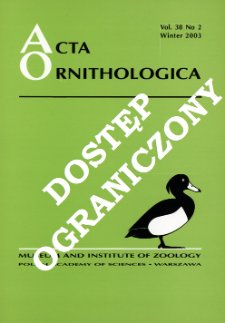
Object
Title: Barn owl Tyto alba predation on small mammals in relation to the Mediterranean environment (Pisa Province, Italy)
Creator:
Varuzza, Paolo ; Capizzi, Dario (1967– ) ; Santini, Luciano ; Apollonio, Marco
Date issued/created:
Resource type:
Subtitle:
Acta Ornithologica, vol. 36, no. 2 ; Drapieżnictwo płomykówki w stosunku do drobnych ssaków w krajobrazie śródziemnomorskim
Contributor:
Polska Akademia Nauk. Muzeum i Instytut Zoologii
Publisher:
Muzeum i Instytut Zoologii PAN
Place of publishing:
Description:
Bibliogr. p. 158-159 ; P. [153]-160 : ill. ; 27 cm ; Abstract in Polish. Taxa in Latin
Type of object:
Abstract:
The diet of the Barn Owl was investigated in 13 localities in Pisa province, Central Italy. In each locality, the percentage of forest and cultivated land, and the linear development of roads and rivers were recorded. To estimate the prey availability, the small mammal communities in seven different localities within the same province were sampled during live trapping sessions. Barn Owls preyed mainly upon rodents (79.4%) and insectivores (18.8%), while birds were eaten only to a small degree (1.8%). The main prey taxon was Apodemus sp. (39.7%), followed by Microtus savii (26.1%). The relative frequencies of these two prey items were negatively correlated. Statistically significant differences were detected in the mean prey weight in the thirteen localities. This was positively associated with the area of woodland and negatively with the area of cultivated land. A positive relationship between prey diversity and cultivation was recorded. This indicates that Barn Owls which forage in cultivated habitats tend to prey on smaller species, mainly shrews and voles, and to have a more diversified prey spectrum. By contrast, owls foraging in wooded areas were more specialized and preyed on larger animals.
Relation:
Volume:
Issue:
Start page:
End page:
Detailed Resource Type:
Format:
Resource Identifier:
Source:
MiIZ PAN, call no. P.257, Vol. 36, No 2 ; MiIZ PAN, call no. P.4568, Vol. 36, No 2 ; click here to follow the link
Language:
Rights:
Rights Reserved - Restricted Access
Terms of use:
Digitizing institution:
Museum and Institute of Zoology of the Polish Academy of Sciences
Original in:
Library of the Museum and Institute of Zoology of the Polish Academy of Sciences
Projects co-financed by:
Programme Innovative Economy, 2010-2014, Priority Axis 2. R&D infrastructure ; European Union. European Regional Development Fund
Access:
Object collections:
- Digital Repository of Scientific Institutes > Partners' collections > Museum and Institute of Zoology PAS > Scientific Journals
- Digital Repository of Scientific Institutes > Partners' collections > Museum and Institute of Zoology PAS > MIZ PAN Publications > Acta Ornithologica
- Digital Repository of Scientific Institutes > Literature > Journals/Articles
Last modified:
Oct 2, 2020
In our library since:
May 23, 2014
Number of object content downloads / hits:
64
All available object's versions:
https://rcin.org.pl/publication/61359
Show description in RDF format:
Show description in RDFa format:
Show description in OAI-PMH format:
Objects Similar
Capizzi, Dario (1967– ) Caroli, Luigi Varuzza, Paolo
Ruprecht, Andrzej L. (1935–2010)
Riga, Francesco Capizzi, Dario (1967– )
Sałata-Piłacińska, Barbara Rachowiak, Przemysław Państwowe Wydawnictwo Naukowe (1951–1992) Polska Akademia Nauk. Instytut Zoologii
Skuratowicz, Wacław (1915–1989) Bartkowska, Klara (1939–2010) Batchvarov, Georgi Państwowe Wydawnictwo Naukowe (1951–1992) Polska Akademia Nauk. Instytut Zoologii
Ziomek, Joanna
Kubik, J. Leniec, H. Sitkowski, W.
Lesiński, Grzegorz Romanowski, Jerzy Gryz, Jakub Olszewski, Adam Kowalski, Marek Krauze-Gryz, Dagny Szulc-Olechowa, Bogumiła Pepłowska-Marczak, Danuta Tarłowski, Adam

 INSTYTUT ARCHEOLOGII I ETNOLOGII POLSKIEJ AKADEMII NAUK
INSTYTUT ARCHEOLOGII I ETNOLOGII POLSKIEJ AKADEMII NAUK
 INSTYTUT BADAŃ LITERACKICH POLSKIEJ AKADEMII NAUK
INSTYTUT BADAŃ LITERACKICH POLSKIEJ AKADEMII NAUK
 INSTYTUT BADAWCZY LEŚNICTWA
INSTYTUT BADAWCZY LEŚNICTWA
 INSTYTUT BIOLOGII DOŚWIADCZALNEJ IM. MARCELEGO NENCKIEGO POLSKIEJ AKADEMII NAUK
INSTYTUT BIOLOGII DOŚWIADCZALNEJ IM. MARCELEGO NENCKIEGO POLSKIEJ AKADEMII NAUK
 INSTYTUT BIOLOGII SSAKÓW POLSKIEJ AKADEMII NAUK
INSTYTUT BIOLOGII SSAKÓW POLSKIEJ AKADEMII NAUK
 INSTYTUT CHEMII FIZYCZNEJ PAN
INSTYTUT CHEMII FIZYCZNEJ PAN
 INSTYTUT CHEMII ORGANICZNEJ PAN
INSTYTUT CHEMII ORGANICZNEJ PAN
 INSTYTUT FILOZOFII I SOCJOLOGII PAN
INSTYTUT FILOZOFII I SOCJOLOGII PAN
 INSTYTUT GEOGRAFII I PRZESTRZENNEGO ZAGOSPODAROWANIA PAN
INSTYTUT GEOGRAFII I PRZESTRZENNEGO ZAGOSPODAROWANIA PAN
 INSTYTUT HISTORII im. TADEUSZA MANTEUFFLA POLSKIEJ AKADEMII NAUK
INSTYTUT HISTORII im. TADEUSZA MANTEUFFLA POLSKIEJ AKADEMII NAUK
 INSTYTUT JĘZYKA POLSKIEGO POLSKIEJ AKADEMII NAUK
INSTYTUT JĘZYKA POLSKIEGO POLSKIEJ AKADEMII NAUK
 INSTYTUT MATEMATYCZNY PAN
INSTYTUT MATEMATYCZNY PAN
 INSTYTUT MEDYCYNY DOŚWIADCZALNEJ I KLINICZNEJ IM.MIROSŁAWA MOSSAKOWSKIEGO POLSKIEJ AKADEMII NAUK
INSTYTUT MEDYCYNY DOŚWIADCZALNEJ I KLINICZNEJ IM.MIROSŁAWA MOSSAKOWSKIEGO POLSKIEJ AKADEMII NAUK
 INSTYTUT PODSTAWOWYCH PROBLEMÓW TECHNIKI PAN
INSTYTUT PODSTAWOWYCH PROBLEMÓW TECHNIKI PAN
 INSTYTUT SLAWISTYKI PAN
INSTYTUT SLAWISTYKI PAN
 SIEĆ BADAWCZA ŁUKASIEWICZ - INSTYTUT TECHNOLOGII MATERIAŁÓW ELEKTRONICZNYCH
SIEĆ BADAWCZA ŁUKASIEWICZ - INSTYTUT TECHNOLOGII MATERIAŁÓW ELEKTRONICZNYCH
 MUZEUM I INSTYTUT ZOOLOGII POLSKIEJ AKADEMII NAUK
MUZEUM I INSTYTUT ZOOLOGII POLSKIEJ AKADEMII NAUK
 INSTYTUT BADAŃ SYSTEMOWYCH PAN
INSTYTUT BADAŃ SYSTEMOWYCH PAN
 INSTYTUT BOTANIKI IM. WŁADYSŁAWA SZAFERA POLSKIEJ AKADEMII NAUK
INSTYTUT BOTANIKI IM. WŁADYSŁAWA SZAFERA POLSKIEJ AKADEMII NAUK


































